Football (soccer) is the most popular sport in the world, with billions of fans in many countries. Massive crowds of fans are one of the reasons the sport has some of the largest stadiums in the world. In this post, we’ll explore the 20 biggest football stadiums in the world, learning when and where they were built and how many people they can seat. The table below lists the 20 largest stadiums along with the seating capacity and location of each.
| Rank | Stadium Name | Seating Capacity | Location |
|---|---|---|---|
| 1 | Rungrado 1st of May Stadium | 114,000 | Pyongyang, North Korea |
| 2 | Melbourne Cricket Ground | 100,024 | Melbourne, Australia |
| 3 | Camp Nou | 99,354 | Barcelona, Spain |
| 4 | FNB Stadium | 94,736 | Johannesburg, South Africa |
| 5 | Rose Bowl | 92,800 | Pasadena, United States |
| 6 | Wembley Stadium | 90,000 | London, England |
| 7 | Lusail Iconic Stadium | 88,966 | Lusail, Qatar |
| 8 | Estadio Azteca | 87,523 | Mexico City, Mexico |
| 9 | Bukit Jalil National Stadium | 87,411 | Kuala Lumpur, Malaysia |
| 10 | Borg El Arab Stadium | 86,000 | Alexandria, Egypt |
| 11 | Salt Lake Stadium | 85,000 | Kolkata, India |
| 12 | Stadium Australia | 83,500 | Sydney, Australia |
| 13 | MetLife Stadium | 82,500 | East Rutherford, United States |
| 14 | Croke Park | 82,500 | Dublin, Ireland |
| 15 | Jakarta International Stadium | 82,000 | Jakarta, Indonesia |
| 16 | Signal Iduna Park | 81,365 | Dortmund, Germany |
| 17 | Stade de France | 81,388 | Saint-Denis, France |
| 18 | Santiago Bernabéu Stadium | 81,044 | Madrid, Spain |
| 19 | Luzhniki Stadium | 81,000 | Moscow, Russia |
| 20 | Shah Alam Stadium | 80,372 | Shah Alam, Malaysia |
20. Shah Alam Stadium
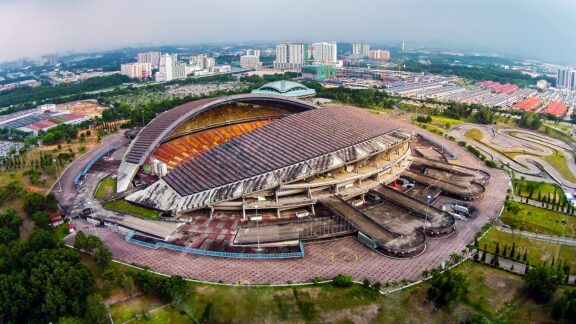
Seating Capacity: 80,372
Country: Malaysia
Originally opened in 1994, Shah Alam Stadium has served as the home stadium of Selangor F.C. since its inception. While the primary use of the stadium is to host football matches, various athletic events also take place here. The design of the stadium was inspired by the Hajduk Split Stadium in Croatia.
Unfortunately, the stadium has fallen into a level of disrepair in recent history, and the Malaysian Football League has stated that it may be barred from hosting matches. The Malaysian government has announced that it will allocate funds to the renovation of the stadium.
19. Luzhniki Stadium
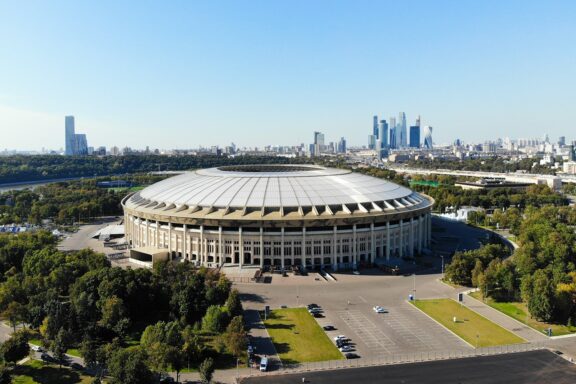
Seating Capacity: 81,000
Country: Russia
One of the biggest football stadiums in the world, Luzhniki Stadium is the national stadium of Russia and the largest in the country. The name of the stadium roughly translates to “meadows” and comes from the flood meadows where the stadium was constructed.
Luzhniki Stadium was first opened in 1956 and went by the name of Central Lenin Stadium until 1992. In addition to functioning as a football stadium, it was the main stadium for the 1980 Olympic Games and has played an important part in many major events.
18. Santiago Bernabéu Stadium
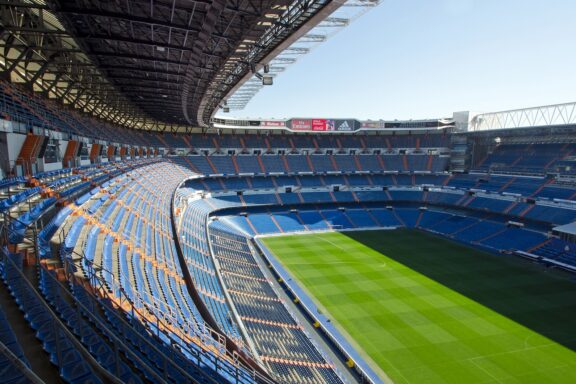
Seating Capacity: 81,044
Country: Spain
Santiago Bernabéu Stadium is the second-largest football stadium in Spain and is the home stadium of Real Madrid. The stadium was constructed in 1947 and was named after the Real Madrid footballer and president, Santiago Bernabéu. It is located in Madrid, the capital of Spain.
The stadium currently has a seating capacity of more than 81,000 and has hosted many internationally significant football events, including the final match in the 1982 World Cup final. It’s one of the most famous football venues in the world.
17. Stade de France
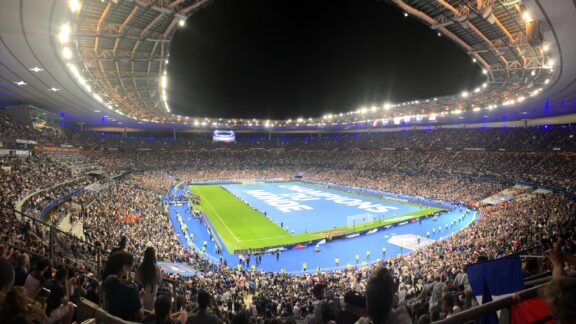
Seating Capacity: 81,338
Country: France
Situated just north of Paris, the capital of France, Stade de France is the national stadium of France as well as one of the largest football stadiums in the world. It was constructed in 1995 ahead of the 1998 World Cup and is the home stadium of the France national football team. It is also the largest stadium to host track and field events in Europe.
In addition to hosting football events, the Stade de France has also hosted auto races and rugby matches. It is slated to host the athletic events at the 2024 Summer Olympics.
16. Signal Iduna Park
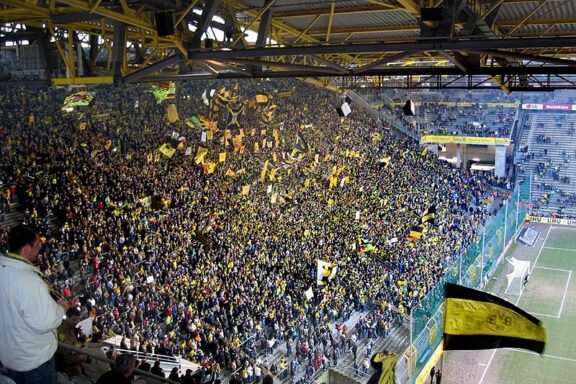
Seating Capacity: 81,365
Country: Germany
Signal Iduna Park, also called Westfalenstadion, is located in the city of Dortmund in North Rhine-Westphalia. The stadium is the largest in Germany and was first opened in 1974, though it has been renovated several times. It hosted matches in both the 1974 and 2006 World Cups and can seat 81,365 people.
The atmosphere generated at football matches in the stadium has earned it a reputation as one of the most famous football stadiums in Europe. It set the European record for average fan attendance in the 2011-2012 season with a total of 1.37 million spectators. The stadium’s south terrace is the largest terrace for standing spectators in Europe and has been nicknamed Die Gelbe Wand, or “The Yellow Wall.”
15. Jakarta International Stadium
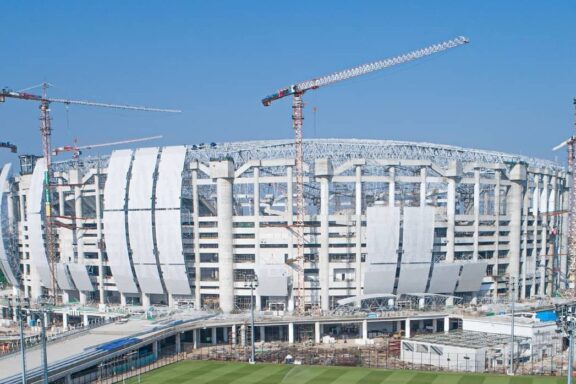
Seating Capacity: 82,000
Country: Indonesia
With a capacity of 82,000 spectators, the Jakarta International Stadium is the largest football-specific stadium in Asia and the largest overall stadium in Indonesia. It is the home of the Persija Jakarta football club as well as the Indonesia national football team. After numerous delays, the stadium was officially opened in July 2022 in the Tanjung Priok district of Jakarta.
One notable feature of this stadium is that it has a retractable roof. This makes it the largest capacity stadium in Asia with a retractable roof and the second-largest in the world in this category.
14. Croke Park

Seating Capacity: 82,300
Country: Ireland
Croke Park is a stadium in Dublin, Ireland that’s been primarily used for Gaelic games since it opened in 1884. The use of the stadium for non-Gaelic games has caused some controversy, but it has hosted matches for the Republic of Ireland national football team as well as the country’s national rugby team.
With a visitor capacity of more than 82,000, Croke Park is the third-largest stadium in Europe. The name of Croke Park comes from Archbishop Thomas Croke, and it is sometimes referred to as “Croker” by locals and fans of Gaelic games.
13. MetLife Stadium
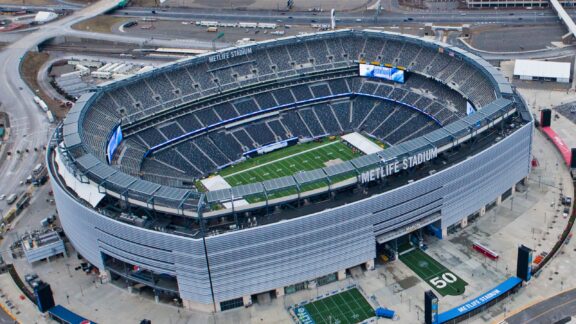
Seating Capacity: 82,500
Country: United States
MetLife Stadium is a giant multi-purpose stadium in East Rutherford, New Jersey, just 5 mi (8 km) away from New York City. It was opened in 2010 and is the home of the New York Giants, an American football team. The stadium has also hosted several international football matches and will host several matches during the 2026 FIFA World Cup.
With the ability to seat 82,500 spectators, MetLife Stadium is the second-largest stadium for football matches in the US and the 13th-largest in the world.
12. Stadium Australia
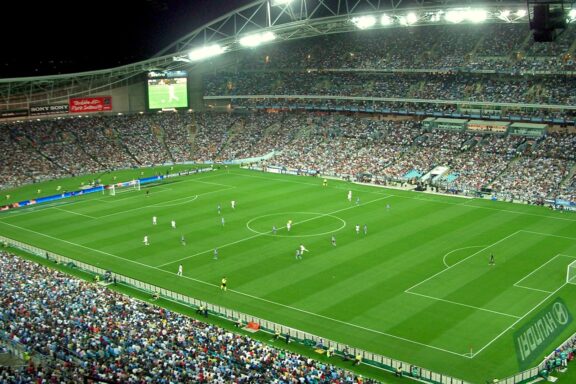
Seating Capacity: 83,500
Country: Australia
Stadium Australia is a multi-purpose stadium located in Sydney, Australia that can accommodate more than 83,500 fans. It was completed in March 1999 to host the 2000 Summer Olympic Games. It’s sometimes to referred to as the Sydney Olympic Stadium and is currently known as Accor Stadium for sponsorship reasons.
Among the various uses for the stadium are cricket, rugby, and football games, motorsports events, concerts, and more. Stadium Australia is where important matches for the Australian national football team are held.
11. Salt Lake Stadium
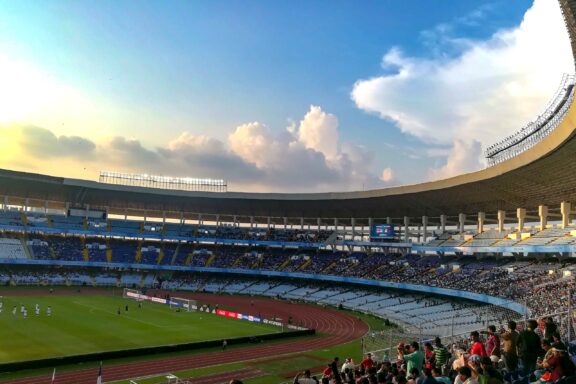
Seating Capacity: 85,000
Country: India
Salt Lake Stadium in India is the 11th-largest football stadium in the world with a capacity for 85,000 spectators. Before its renovation in 2011, the stadium could hold 120,000 visitors, making it the biggest football stadium in the world. Although the stadium is commonly called Salt Lake Stadium, its official name is Vivekananda Yuba Bharati Krirangan, which translates to “Vivekananda Indian Youth Stadium.” It is named after Swami Vivekananda.
The massive stadium functions as a multi-sport venue and several professional football clubs call the stadium home. These teams include ATK Mohan Bagan, East Bengal, and Mohammedan.
10. Borg El Arab Stadium
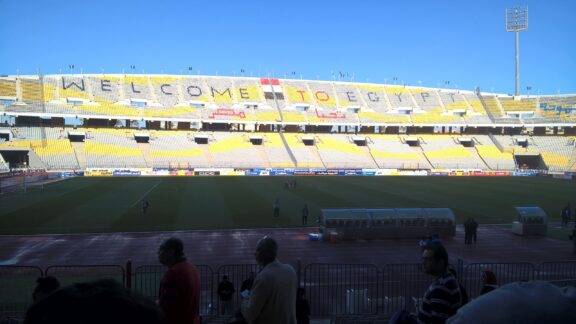
Seating Capacity: 86,000
Country: Egypt
With a seating capacity of 86,000, the Borg El Arab Stadium in Egypt is the first stadium on this list to make the top ten largest in the world. Located 25 km (15.5 mi) outside of Alexandria, it is the largest stadium in Egypt and the second-largest in Africa. It is also sometimes referred to as the Egyptian Army Stadium.
The stadium was first opened in 2009 and was commissioned as part of Egypt’s bid to host the 2010 FIFA World Cup, although the bid did not succeed. The stadium is the home of the Egyptian national football team.
9. Bukit Jalil National Stadium
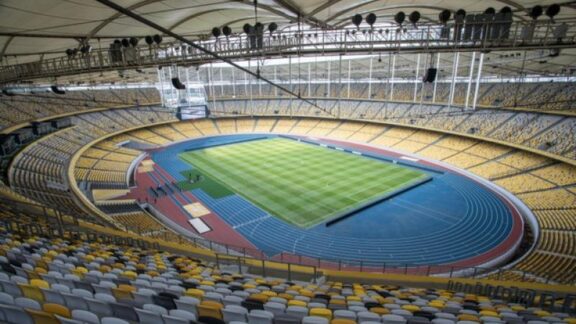
Seating Capacity: 87,411
Country: Malaysia
Located in the Bukit Jalil suburb of Kuala Lumpur, the capital of Malaysia, Bukit Jalil National Stadium is a multi-purpose stadium and the home of the Malaysian national football team. The stadium can sit 87,411 people and is the ninth-largest in the world, the third-largest in Asia, and the largest in Southeast Asia.
The stadium was constructed in 1995 ahead of the 1998 Commonwealth Games and was opened on January 1st of 1998. It has since served as a host for several international sporting events such as the 2001 and 2017 Southeast Asian Games, 2006 FESPIC Games, and 2008 ASEAN University Games.
8. Estadio Azteca
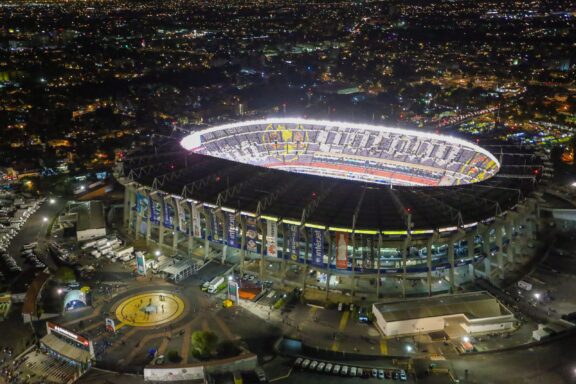
Seating Capacity: 87,523
Country: Mexico
Mexico City’s Estadio Azteca is one of the most iconic football stadiums in the world. It was first opened in 1966, has been renovated four times, and can seat 87,523 spectators. The stadium is the largest in Mexico and Latin America, and it’s used to host a variety of events.
Estadio Azteca was the first stadium to host two FIFA World Cup Finals and it is the home stadium of Club América, Cruz Azul, and the Mexico national football team. The stadium is named as a tribute to the Aztec heritage of Mexico City.
7. Lusail Stadium
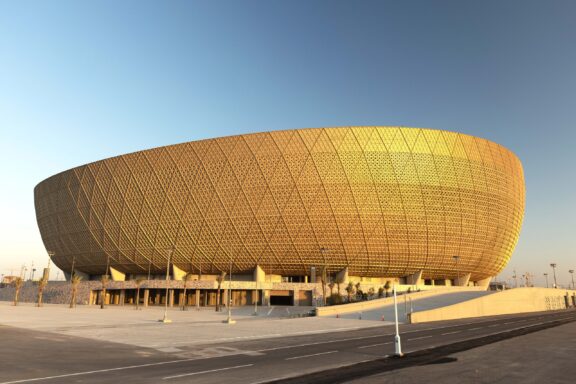
Seating Capacity: 88,966
Country: Qatar
Lusail Stadium, also called Lusail Iconic Stadium, is located in Qatar and is one of eight stadiums that were constructed to host the 2022 FIFA World Cup matches. Its current capacity of 88,966 makes it the seventh-biggest football stadium in the world, but this will change when its capacity is reduced to 40,000 in an upcoming renovation.
Construction of the stadium began in 2017 and was tied to a number of human rights violations against migrant workers. The stadium was opened in November 2021.
6. Wembley Stadium
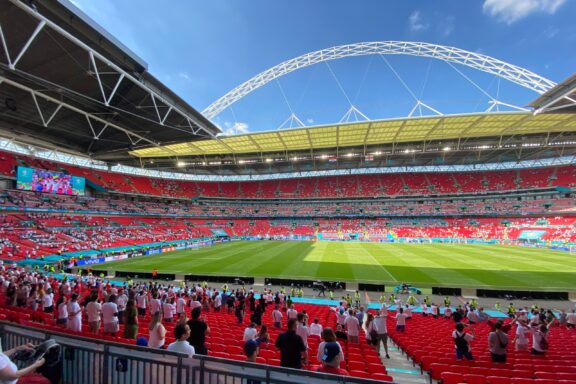
Seating Capacity: 90,000
Country: England
The biggest football stadium in the UK and the second-largest in Europe is London’s Wembley Stadium. It can seat 90,000 fans and hosts major football matches like the home matches of the England national football team.
The current Wembley Stadium was opened in 2007 and was built on the site of the original stadium, which was demolished in 2003. The Wembley Arch is 134 meters (440 ft) high and serves as a London landmark as well as a structural support for the stadium’s roof.
5. Rose Bowl
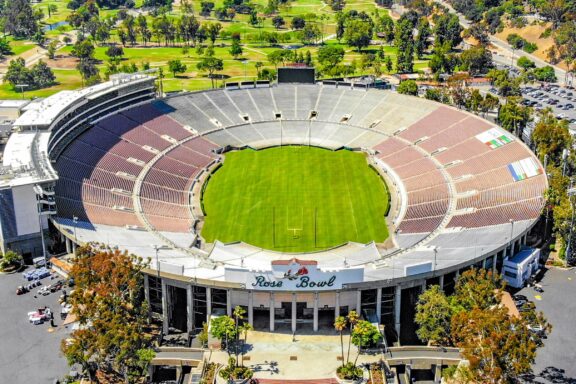
Seating Capacity: 92,800
Country: United States
Situated 16.1 km (10 mi) northeast of Los Angeles, California is the Rose Bowl, one of the biggest football stadiums in the world. It was first opened in 1922 and has hosted a number of significant sporting events including FIFA World Cup matches, the 1984 Olympic Soccer Gold Medal Match, and numerous CONCACAF matches.
The Rose Bowl is best known in the United States for being an American college football venue and its annual Rose Bowl Game.
4. FNB Stadium
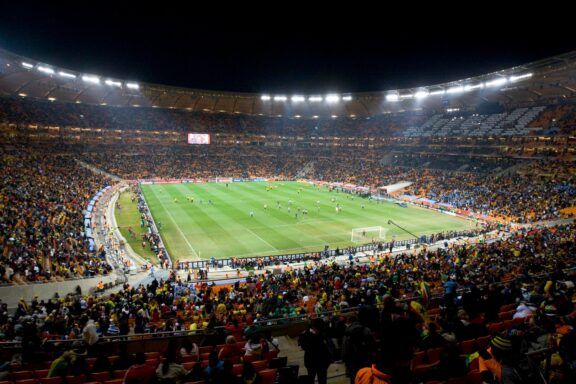
Seating Capacity: 94,736
Country: South Africa
First National Bank (FNB) Stadium is located in the Nasrec suburb of Johannesburg, South Africa and hosts both rugby and association football matches. It is home of the Kaizer Chiefs football club and supports the South African national football team. The stadium’s nickname is “The Calabash” due to its resemblance to the African gourd, and it’s also referred to as “Soccer City.”
FNB Stadium is the largest in Africa and hosts a variety of local and international sports matches, including the 2010 FIFA World Cup Final. It also functions as a concert venue.
3. Camp Nou
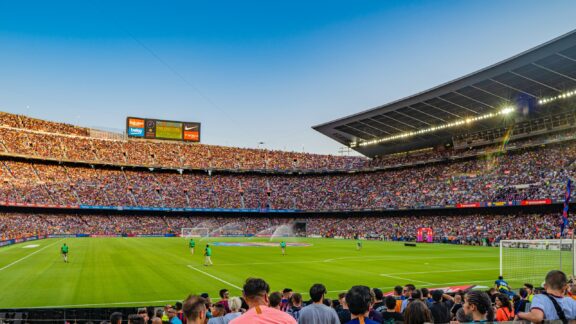
Seating Capacity: 99,354
Country: Spain
The largest football stadium in Europe is Camp Nou, which translates to “New Field” in English. It’s officially named Spotify Camp Nou for sponsorship purposes. The stadium is located in Barcelona, was opened in 1957, and has been the home stadium of FC Barcelona since its inception.
Along with being among the biggest stadiums in the world, Camp Nou has been the site of many significant international football matches, including Champions League Finals, European Cup Winners’ Cup Finals, and five matches of the 1982 World Cup.
2. Melbourne Cricket Ground
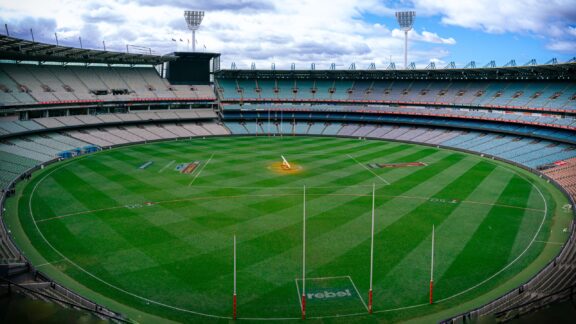
Seating Capacity: 100,024
Country: Australia
The second-largest football stadium in the world is the Melbourn Cricket Ground, which can seat more than 100,000 people and is located in Melbourne, Australia. The stadium has a long history — it was opened in 1953 and has undergone several renovations. It is known locally as “The MCG” or “The ‘G” and was added to the Australian National Heritage List in 2005.
Some of the significant events that have taken place here include the 1956 Summer Olympics, the 2006 Commonwealth Games, two Cricket World Cups, and FIFA World Cup qualifiers. It is also a main venue for Australian Football League matches.
1. Rungrado 1st of May Stadium
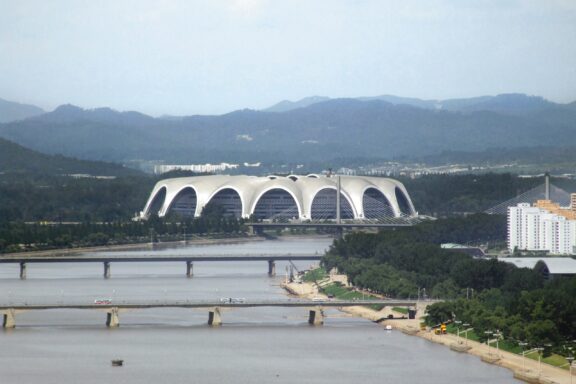
Seating Capacity: 114,000
Country: North Korea
Rungrado 1st of May Stadium is the largest football stadium in the world and is located in Pyongyang, North Korea. It was initially constructed as part of a successful bid to host the 13th World Festival of Youth and Students in 1989 and opened in May of the same year.
The stadium is used for a variety of purposes, including football matches, but it is more often used for gigantic performances and shows such as the mass games of the Arirang Festival. The stadium’s design features 16 arches arranged in a ring and resembling a magnolia blossom.